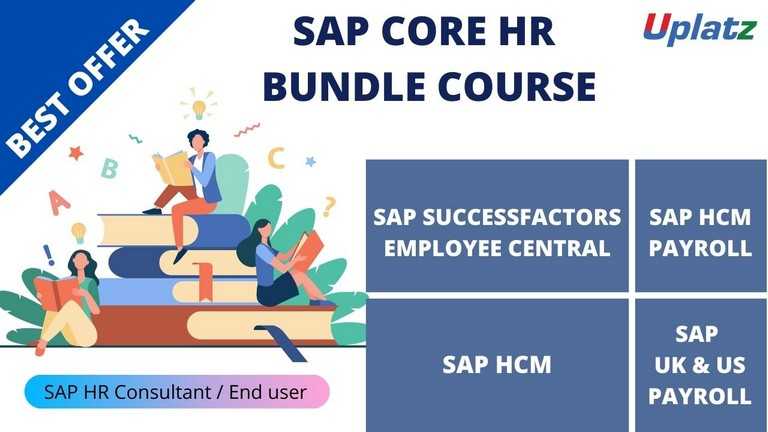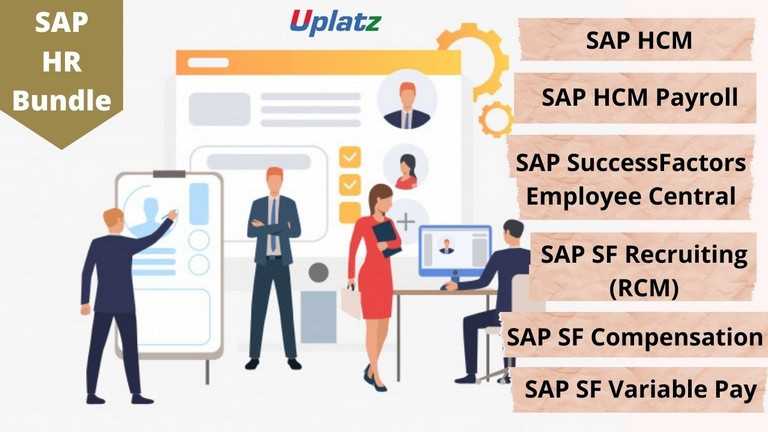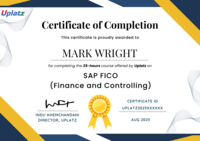Bundle Course - SAP HCM and SAP US Payroll
Learn about designation, role, salary details, working shifts, address and more.Preview Bundle Course - SAP HCM and SAP US Payroll course
Price Match Guarantee Full Lifetime Access Access on any Device Technical Support Secure Checkout Course Completion Certificate 77% Started a new career
BUY THIS COURSE (
77% Started a new career
BUY THIS COURSE (GBP 22 GBP 49 )-
 87% Got a pay increase and promotion
87% Got a pay increase and promotion
Students also bought -
-

- Bundle Course - SAP Core HR (HCM - HCM Payroll - SuccessFactors EC - UK Payroll - US Payroll)
- 100 Hours
- GBP 22
- 485 Learners
-

- Bundle Course - SAP HR (HCM - HCM Payroll - SuccessFactors EC - SF RCM - SF Compensation - SF Variable Pay)
- 125 Hours
- GBP 22
- 782 Learners
-

- Bundle Multi (2-in-1) - SAP HCM
- 50 Hours
- GBP 22
- 346 Learners

This Bundle Course consists of two modules :
1. SAP HCM
2. SAP US Payroll
SAP HR records the data from the hiring an employee to its final termination in organization. It store the employee data such as designation, role, salary details, working shifts, address and so on.
SAP HCM : (SAP Human Capital Management) is a human resources management system. As the successor to SAP HR, it contains all functions that are relevant for personnel administration, payroll, applicant management, and personnel development. In addition, SAP HCM links personnel management and personnel management with multi-level application and approval processes. In addition, the system is closely linked to the organizational structure, whereby hierarchy-dependent processes can be automated. Adaptation to company-specific conditions is possible by integrating numerous submodules.
SAP HR is divided in to various sub modules such as
a).Organizational management
b).Personnel Administration
c).Time Management
d).Payroll
e).Personnel Development
SAP US Payroll : United States Payroll should be implemented in cooperation with the project team implementing other areas of SAP HR, particularly Personnel Administration. Since US Payroll uses an interface to a separate BSI TaxFactory database to calculate taxes, you need to consult with networking, database and Basis personnel during some parts of the implementation.
This component allows you to process payroll for employees in the United States, using data from SAP Personnel Administration and Benefits under a wide variety of configurations. You can also run payroll using a combination of SAP and third party products. The SAP Payroll system also offers a number of standard payroll reports. The Tax Reporter component allows you to generate all required state and federal tax forms, such as SUI reports and W-2s. Further reports can be generated using Ad Hoc Query in conjunction with an SAP Payroll Infotype.
Course/Topic 1 - SAP HCM - all lectures
-
In this Video you will learn about Organization Management and its elements. You will also learn how to set up org structure in SAP HCM process.
-
In this lecture video session we learn about organisation management and also cover creation of folder transaction codes on SAP access.
-
In this lecture session we learn about setup number assignment for all plan versions in organisation management in SAP.
-
In this lecture session we learn about simple maintenance and also cover two ways in which we can create SAP HCM structure.
-
In this lecture session we learn about expert mode structure and also cover types of structure present in SAP HCM.
-
In this lecture session we learn about expert mode and also cover how we create the object in expert mode.
-
In this lecture session we learn about structure display and maintenance and organisation structure with work centers.
-
In this lecture session we learn about master data structure and also learn about enterprise structure in SAP HCM.
-
In this lecture session we learn about how we create name affixes and also cover creating possible academic tiles in HCM.
-
Personal Administration - Part 3- In this lecture video we learn about infotype and sub info type in SAP HCM.
-
In this lecture session we learn about contractual and corporate agreement in SAP HCM.
-
In this lecture session we learn about organisation data in SAP and also talk about master data maintenance.
-
In this lecture session we learn about performance assistants and also cover education and training.
-
In this lecture session we learn about p-30 maintenance and also talk about display and personal files.
-
In this lecture session we learn about workforce requirements and advertisement in SAP HCM.
-
In this lecture video we learn how to create a short profile in SAP HCM and also talk about all the steps of creating a short profile.
-
In this lecture session we learn about how we manage the initial data in recruitment.
-
In this lecture session we learn about enterprise compensation management in SAP HCM and also talk about enterprise compensation management.
-
In this lecture session we learn about compensation management and also cover compensation areas.
-
In this lecture session we learn about guidelines and also cover calculating methods in SAP HCM.
-
In this video session we learn about benefits models and also talk about health plans, insurance plans and saving plans in SAP HCM.
-
In this lecture session we learn about flexible benefits scheme attributes in SAP HCM and also talk about plan attributes in SAP.
-
In this video tutorial we learn about compensation of benefits and also cover insurance plan general data in SAP.
-
In this lecture session we learn about family members grouping modules in SAP and also cover the master data.
-
Lecture 25 - Employee Self Service & Management Self Service - ESS & MSS - Part 1
-
In this lecture session we learn about employees self services and management self services in SAP HCM.
-
In this lecture session we learn about training and event management in SAP and also cover the master data maintenance in HCM.
-
In this lecture session we learn about business event location switches and also cover how we create location in SAP HCM.
-
In this lecture session we learn about business event menus and also cover types of business event menus in SAP HCM.
-
In this session of SAP Payroll which is one of the key modules in SAP Human Capital Management. It is used to calculate the remuneration for each employee with respect to the work performed by him.
-
In this lecture session we learn about valuation of absences and also cover creating counting classes for valuation absences in SAP HCM payroll.
-
In this lecture video session we learn about assign wage type model for pay scale grouping for allowances in SAP HCM.
-
In this lecture video session we learn about assigning universal contribution grouping for universal contribution types and also cover professional tax in SAP.
-
In this lecture session we learn about SAP menu and also cover types of SAP menu in SAP HCM Payroll.
-
This video describes the SAP HCM Payroll configuration process and the wrappers around it.
-
In this lecture video session we learn about time management and work schedule in SAP HCM.
-
In this lecture session we learn about setting default values for the work schedule in SAP HCM.
-
In this lecture session we learn about work schedule rules in SAP and also talk about all rules of SAP HCM.
-
In this lecture session we learn about integration of SAP HR with FI in SAP HCM.
-
In this lecture video session we talk about "real time concepts" of SAP HCM module.
-
This video describes the Real-time LSMW (Legacy System Migration Workbench), a tool that supports single or periodic data transfer from non-SAP to SAP systems.
Course/Topic 2 - SAP US Payroll - all lectures
-
In this lecture session we learn about basic play in SAP US payroll and also talk about two main categories.
-
In this lecture session we learn about the payscale process and also talk about features of payroll drivers in brief.
-
In this lecture session we learn about payroll schema in SAP US payroll and also talk about features of payroll control record in brief.
-
In this lecture session we learn about additional payments in brief and also talk about payments and deduction in brief.
-
In these lecture sessions we learn about how we maintain HR master record and also talk about features of change in residence tax area.
-
In this lecture session we learn about posting FI in SAP US payroll and also talk about features of posting FI in brief.
-
In this lecture session we learn about flexi work schedule and time management in SAP US payroll.
-
In this lecture session we learn about absences and counting rules in SAP US payroll and also talk about features of absences counting.
-
In this lecture session we learn about time evaluation for absences in SAP us payroll and also talk about features of time evaluation for absences.
-
In this lecture session we learn about attendance time evaluation and also talk about different types of drivers.
-
In this lecture session we learn about benefits management USA in brief and also talk about features of benefits management USA.
-
In this lecture session we learn about benefits for medical in SAP US payroll and also talk about features of benefits for medicals.
-
In this lecture session we learn about benefits wage and types and enrollment in SAP US payroll and also talk about function of benefits wages.
-
In this lecture session we learn about insurance benefits plans and also talk about features of insurance benefits plans.
-
In this lecture session we learn about LSMW master data management and also talk about features of LSMW master data management.
a).How to do organizational management
b).How to do personnel administration
c).How to do time Management
d).About Payroll
e).About Personnel Development
Course Syllabus: SAP HCM and SAP US Payroll Bundle
Overview
The SAP HCM and SAP US Payroll course bundle is designed to equip HR professionals and system administrators with comprehensive knowledge of Human Capital Management (HCM) and the specific functionalities of managing US Payroll within the SAP environment. This course emphasizes both the foundational aspects of HCM and the complexities of US payroll processing.
Module 1: Introduction to SAP HCM
This module provides an overview of SAP HCM, including its architecture, key components, and integration with other SAP modules. Participants will learn about the employee lifecycle, the role of HR in organizations, and how SAP HCM supports effective workforce management.
Module 2: Personnel Administration
In this module, participants will delve into personnel administration processes. Topics include managing employee master data, handling personnel actions, and utilizing self-service functionalities. The importance of accurate data management for effective HR operations will be emphasized.
Module 3: Organizational Management
This module focuses on organizational management within SAP HCM. Participants will learn how to create and manage organizational structures, job roles, and reporting hierarchies. The role of organizational management in strategic HR planning and workforce development will also be discussed.
Module 4: Introduction to US Payroll
This section introduces participants to the US Payroll module within SAP HCM. Key topics include understanding payroll processing cycles, statutory compliance, and the integration of payroll with other HR functions. Participants will gain insights into the specific requirements for managing US payroll.
Module 5: US Payroll Processing
This module dives deeper into the intricacies of US Payroll processing in SAP. Participants will learn how to configure US Payroll, manage payroll runs, and handle various payroll scenarios, including deductions, taxes, and benefits administration. The course will cover compliance with federal and state regulations.
Module 6: Reporting and Analytics in SAP HCM
Participants will explore the reporting and analytics capabilities within SAP HCM and US Payroll. This module will cover standard reporting tools, custom report creation, and the importance of analytics in making informed HR decisions. Participants will learn how to generate and analyze payroll and HR reports.
Module 7: Integration with Other SAP Modules
This final module focuses on the integration of SAP HCM and US Payroll with other SAP modules, such as Financial Accounting (FI) and Time Management. Participants will understand data flows and processes that ensure seamless HR and payroll operations across the organization.
Conclusion
By the end of the course, participants will have a thorough understanding of SAP HCM functionalities and US Payroll processing. They will be equipped with the skills necessary to effectively manage HR processes and ensure compliance with US payroll regulations.
Assessment
Participants will be assessed through quizzes, practical assignments, and a final project that demonstrates their understanding of SAP HCM and US Payroll processes.
The SAP HCM and SAP US Payroll Certification ensures you know planning, production and measurement techniques needed to stand out from the competition.
SAP HCM Payroll (also called SAP Payroll) is a sub-module of SAP Human Capital Management that helps the HR department of an organization to manage the payroll processes. Payroll is a process to calculate the salary and wages of permanent and temporary employees of an organization.
After successful completion of this course, you can become an SAP MM consultant, an HR generalist, an SAP HCM general consultant or an SAP HR functional consultant. This degree will also help you secure the post of an HR officer, an assistant manager HR, an HR recruiter or even an HR executive.
1.Knowledge of Business Process in the area of Human Resources / Organization Management/ Administration.
2.1 -2 years domain experience in HR portfolio is plus.
3.Professional qualification: Any graduates or post graduates.
4.Good communication skills.
Uplatz online training guarantees the participants to successfully go through the SAP Cloud (CPI - HCI) certification provided by Uplatz. Uplatz provides appropriate teaching and expertise training to equip the participants for implementing the learnt concepts in an organization.
Course Completion Certificate will be awarded by Uplatz upon successful completion of the SAP Cloud (CPI - HCI) online course.
The SAP HCM and SAP US Payroll draw an average salary of $98,080 per year depending on their knowledge and hands-on experience. The SAP HCM and SAP US Payroll job roles are in high demand and make a rewarding career.
First Step to Becoming SAP HCM Consultant (Choose)
Accounting people, running payroll, motivating people. Accounting people is about how every single person is placed in an organization structure. These HR consultants do organizational management setup, time tracking, and personnel administration.
The main modules of SAP HR are the Payroll and Time Management modules which are concerned with generating and managing payrolls and managing time for time-sensitive jobs. If you want to join SAP HR, then successfactors online training is the best one that you can choose..
SAP HCM Interview Questions
Q1).List The Various Components Of The Enterprise Structure In Systems, Applications, And Products (SAP) In Human Capital Management (HCM)?
Ans: The components of the enterprise structure in SAP HCM are given as follows:
a) Client
b) Company code
c) Personnel area
d) Personnel subarea
Q2).What Is Client In The SAP System?
Ans: In the SAP R/3 (R stands for Real-time) system, a client is an organization and a legal entity. A client is positioned at the highest level among all the organizational units. It contains the master data of various business processes, such as customers, products, and vendors. A three-digit number is used to represent clients in the SAP R/3 system.
Q3).What Is the Company Code?
Ans: A company code is a unique four-character alphanumeric code that represents a legally independent enterprise.
Q4).What Is Personnel Area?
Ans: A personnel area is a subunit of the company code. It is identified as an organizational unit representing an area in an enterprise, which is organized according to personnel administration, time management, and payroll accounting criteria. It is represented as a four-character alphanumeric code. For example, the personnel area code for a corporation is CORP.
Q5).What Are Personnel Subareas?
Ans: A personnel subarea is a part of the personnel area, which can be subdivided according to the geographical location or the strategic line of business. It is represented as a four-character alphanumeric code. For example, if the branches or locations of an organization are defined as personnel areas, then its departments, such as HR and ADMIN, are the personnel subareas of the organization.
Q6).What Is SAP HCM Workflow?
Ans: The SAP HCM Workflow automates business processes and assigns tasks to appropriate persons at the right time.
Q7).What Do You Mean By Info types In SAP HCM?
Ans: Info types are referred to as system-controlled characteristics of employees. Information related to an employee is stored in the form of Infotypes,
Q8).which are represented by a four-digit numeric code given as follows:
Ans:
a) 0000 for actions
b) 0001 for organizational assignment
c) 0002 for personal data
d) 0003 for payroll status
Q9).What Are Features In SAP HCM?
Ans: Features are decision trees customized in the Implementation Guide (IMG) screen in SAP HCM that are made up of technical fields whose values are defaulted in the easy access.
Q10).How Do You Hire A New Employee?
Ans: A new employee is hired with the PA40 transaction code. After that, all the Infotypes are maintained for the employee by using the PA30 transaction code.
Q11) What are the three administrators?
Ans: The three administrators are :
1) Personnel Administrator
2) Payroll Administrator
3) Time Administrator
Q12).How does any company use an organizational plan?
Ans:The company organization structure and reporting structure are represented through the organization plan. The active plan version is the current plan version and the other plan versions are considered as various planning Stages. Used for manpower planning. Normally plan version"01" is always made the active plan version.
Q13).What is an evaluation path?
Ans: An evaluation path describes a chain of relationships that exists between individual organizational objects in the organizational plan.
You can maintain evaluation paths on img -> Personnel Management ->Organization Management-> Basic Settings-> Maintain Evaluation Paths .
Q14).What is the difference between a job and a position?
Ans: Job is not concrete, it is generic. (Eg: Manager, Assistant Manager, Consultant). Positions are related to persons. The position is concrete and specific which is occupied by Persons. (Eg: Manager – Finance, Consultant – SAP HR).
Q15).What are Dynamic Actions? Give a few examples?
Ans:Dynamic actions when triggered by the system. They are the result of some personnel actions. If changes are made (personnel action) to the personnel data of an info type, then has an effect on the data of a second info type, the system automatically displays the info type. One of the main purposes of the dynamic action (of the system) is to have consistent and coherent data. These actions are started automatically by the system, unlike the Personnel actions which you start by yourself. The best example is when an action is carried out like hiring; it needs to populate a set of info types. In the initial entry of details in info type 0000 is personnel action. Then the system automatically displays the next info types- which are the result of dynamic action.
SAP US PAYROLL Interview Questions
Q1.What Is Period Parameter In Systems, Applications And Products In Data Processing (sap) Payroll?
Answer :In SAP payroll, the period parameter specifies the time period for which salary is calculated, such as monthly, bi-monthly, weekly, or annually.
Q2. What Is A Date Modifier?
Answer :Date modifiers are used to define several payment dates for various payroll areas for which the same period parameter is assigned.
The following table shows the various date modifiers:
Date Modifier Description
a) Payment date on 1st day of the month
b) Payment date on 15th day of the month
c) Payment date on 25th day of the month
Q3.What Is The Payroll Control Record?
Answer :payroll control record is a control indicator that controls individual stages of a payroll. It defines the current payroll period and payroll past for retroactive accounting.
Q4.What Is The Use Of Payroll Areas?
Answer:The payroll area fulfills the following two functions that are necessary for a payroll:
a) Groups the personnel numbers together, which are to be processed on the same date.
b) Determines the exact payroll period.
Q5.What Are Payroll Periods?
Answer :Payroll periods are generated for every combination of period parameter and date modifier that are assigned to a payroll area. These are always defined within a specified time interval.
Q6.List The Steps Involved In Creating A Payroll Results Infotype (it 0402).?
Answer:Following are the steps required to create a Payroll Results Infotype:
a) Define the evaluation wage types
b) Set up the Payroll Infotype Assignment, which is used to write the payroll data automatically
c) Assign the evaluation wage types to one or more wage types from the payroll results
d) Assign the evaluation wage types to Payroll Results Infotype
Q7. What Is Primary Wage Type?
Answer:The primary or dialog wage types are defined based on the requirement of the organization. They are the standard wage types defined by SAP and start with a number, such as 1012.
Q8. What Are The Two Main Categories Of Wage Types?
Answer:The two main categories of wage types are primary or dialog wage type and secondary or technical wage type.
Q9. What Are Wage Types In The Sap System?
Answer :The wage types are used to assign the payments and deductions in the employee's payroll. It is also used to control the payroll program.
Q10. What Is The Use Of Pay Scale Group And Pay Scale Level?
Answer :The pay scale group schedules the job evaluations and indirect evaluations. The pay scale groups are divided into pay scale levels, which are used to define the level of jobs.
Q11. What Are Pay Scale Areas?
Answer :The pay scale areas represent the geographical regions to which a pay scale or Collective Agreement Provision applies.
Q12.What Is The Pay Scale Type?
Answer :The pay scale types are two-character keys defined for each region.
Q13. What Is The Tarif Feature?
Answer :The standard system contains the TARIF feature, which takes the default values from the pay scale type and pay scale area assigned to the personnel area.
Q14. What Is The Pay Scale Structure?
Answer :The pay scale structure comprises the following four elements:
a) Pay scale type
b) Pay scale area
c) Pay scale group
d) Pay scale level
Q15.What Is Employee Subgroup Grouping For Personnel Calculation Rule?
Answer :The employee subgroup grouping for personnel calculation rule is defined as a division of employee subgroups, and for these subgroups the same personnel calculation rules are defined for payroll accounting and evaluation in payroll.









